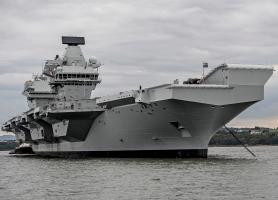 The UK’s latest and greatest new aircraft carrier, HMS Queen Elizabeth is driven not by nuclear power but by fossil fuels. Why is that? The Save the Royal Navy blog has an interesting analysis. Here are a few of the salient points:
The UK’s latest and greatest new aircraft carrier, HMS Queen Elizabeth is driven not by nuclear power but by fossil fuels. Why is that? The Save the Royal Navy blog has an interesting analysis. Here are a few of the salient points:
1. The Navy oiler is already there.
The biggest selling point for nuclear power is that a nuclear-powered ship only needs to be refueled once every 25 years, give or take. In the case of an aircraft carrier, however, the ship is not the only hardware which requires fuel.
As long as the aircraft on the ship are in use, they require lots and lots of fuel, so a Navy oiler is already part of the carrier battle group. And since most of the carrier battle group is also powered by fossil fuels, several Navy oilers are required.
As virtually every other ship and plane requires fuel oil, providing oil for the carrier is not that big a deal, especially as it is likely that the Royal Navy will be spending most of its time in the Atlantic, a smaller ocean, as compared to the Pacific, making replenishment that much easier.
2. Nukes cost more and are more difficult to run.
Nuclear powered ships cost considerably more to build than conventional vessels. They also cost more to run. Even though HMS Queen Elizabeth will burn hundreds of thousand of tonnes of fuel, her refueling costs are still significantly lower than the life-cycle cost of a nuclear plant. And no one really has the answer of what to do with spent nuclear fuel which can remain deadly for hundreds of thousands of years.
Conventional ships, even with advanced propulsion systems like the CODLAG (combined diesel-electric and gas turbine) system on the HMS Queen Elizabeth are far easier to operate and arguably more versatile than a nuclear plant. Many more engineers are trained to operate and maintain diesel engines and gas turbines than nuclear plants. Operationally, diesel/gas turbine power plants can be fired up and shut down quickly, which is not the case with nukes. Diesel/gas turbine plants are also smaller and lighter than nuclear plants, providing more space in the ship for hangar decks and accommodations.
3. Learning from the Charles de Gaulle
France’s one nuclear-powered aircraft carrier, Charles de Gaulle, took 11 years to build compared to the Queen Elizabeth’s 8. The StRN blog notes:The de Gaulle was delivered 5 years late, expensive and beset by technical problems with her propulsion. The K15 nuclear reactor design, derived from existing submarines, proved underpowered and inadequate shielding exposed crew members to doses of radiation that exceed regulations. France is already studying options for replacing the de Gaulle, a ship that has spent more time in dock than operational.
The interesting question raised by the powering of the HMS Queen Elizabeth is, “is nuclear power worth the cost on surface ships?”

Nuclear powered ships cost considerably more to build than conventional vessels. They also cost more to run. Even though HMS Queen Elizabeth will burn hundreds of thousand of tonnes of fuel, her refueling costs are still significantly lower than the life-cycle cost of a nuclear plant. And no one really has the answer of what to do with spent nuclear fuel which can remain deadly for hundreds of thousands of years.
-The same is no doubt true for land based power plants too!